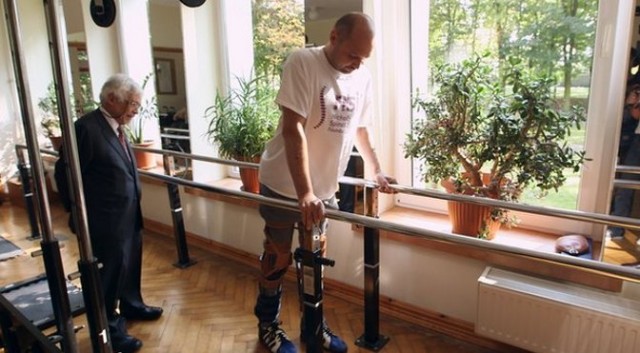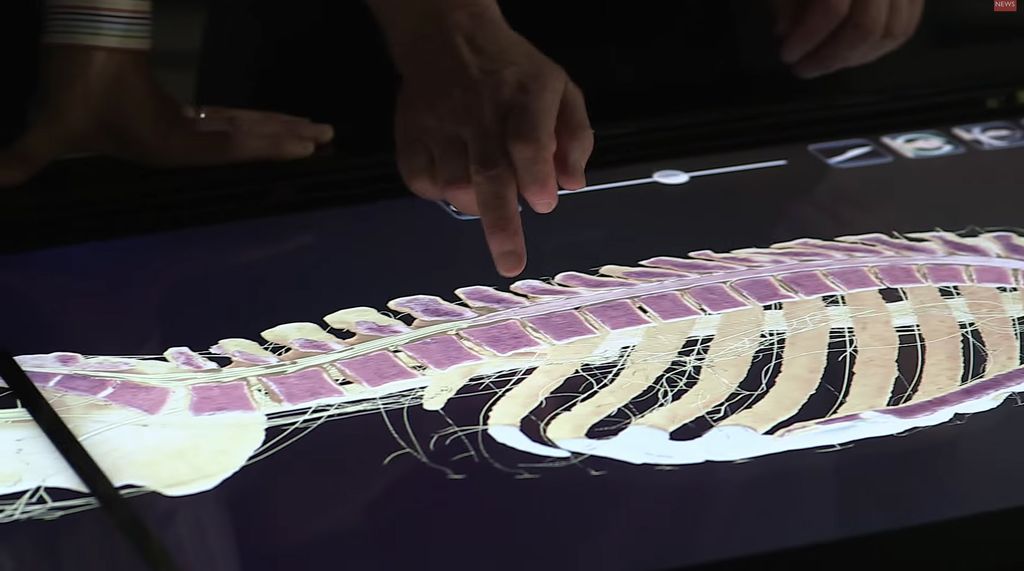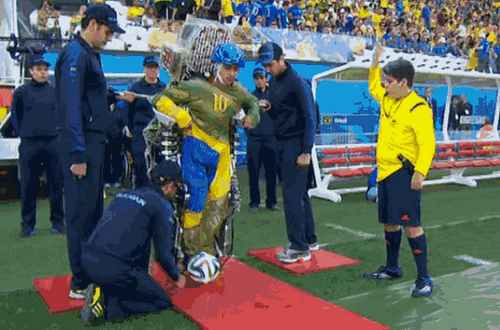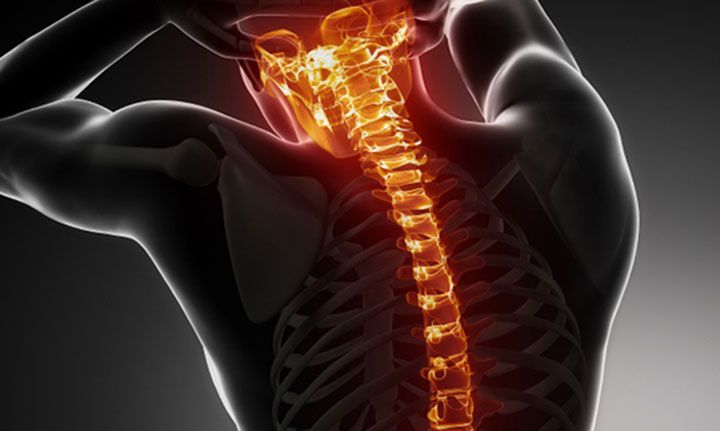

One of the hallmarks of modern medicine is the way it is taking diseases and conditions once thought to be chronic and incurable, and presenting promising solutions. For instance, ongoing research and innovation are leading to new treatments that are restoring mobility for patients who suffer from full or partial paralysis. Whereas in previous decades, a spinal injury could mean a lifetime of diminished mobility, in the future, it may very well become a temporary affliction.
Consider the case of Darek Fidyka, a Hungarian man who was stabbed in the back four years ago and became paralyzed from the chest down. After a year of rehab and no apparent improvement, surgeons tried something radical. In short,they extracted olfactory cells from Fidyka's body – i.e. cells from the back of the nose - and transplanted them into the eight-millimeter gap at level T9 in his severed spinal cord. As a result, Fidyka can now walk - albeit still with some difficulty.
The procedure was funded by the UK-based Nicholls Spinal Injury Foundation, a project set up by David Nicholls after his son was paralyzed in a shallow water diving accident. Having brought together Geoff Raisman, chair of neurology at University College London’s Institute of Neurology, and surgeon Pawel Tabakow from Wroclaw Medical University in Poland (where the procedure was performed), they used stem cells harvested from Fidyka’s own olfactory system to foster regeneration in the severed section of his spine.

For several reasons, the olfactory system is one of the only parts of the human body that repopulates itself with fresh neurons and support cells on a regular basis. After 40 years of research into regeneration, Raisman zeroed in on a particular kind of cell - the olfactory ensheathing cell (OEC) - as the best possible candidate for neural regrowth. This cell is what ensures that nerve connections that are inevitably lost during the cell repopulation process are able to regrow.
Technically, OECs are known as radial glial cells, a kind of cell that provides niche nutrients and physical support for neurons. But researchers have found that this cell also shares much in common with the insulating cells that myelinate the axons of neurons, and to some extent provide a “mechanical memory” for their former targets. Raisman was the first to really understand the power of the OEC and spearhead their use for spinal regeneration where other methods based on stem cells have come up short.
One thing that Raisman discovered in the course of clinical trials using rats is that all OECs are not created equal. The OECs in the mucosa that lines the olfactory cavity do not support regeneration to the extent that OECs from the olfactory bulb do. Furthermore, another kind of cell, the olfactory fibroblast, proved to be an essential connective-tissue-forming cell that needed to be transplanted along with OECs to get the full benefit.
The full procedure was detailed in a study published in Cell Transplantation. According to the study, the OEC and ONF cells were able to join the severed spine in less than five weeks. It took another 19 months of physiotherapy rehabilitation before Fidyka began to feel sensation in his leg, and another six months before he was able to walk (with the help of a walker).

Naturally, other scientists around the world are exercising caution before calling this a breakthrough and giving false hope to people.
“What we see in the report is almost an anecdotal report of one person who received a type of cell … It in itself may be promising, but it’s too early to say whether this is a breakthrough or not,” said Dr. Wolfram Tetzlaff, a professor at University of British Columbia.
However, Dr. Charles Tator, a neurosurgeon at Toronto Western Hospital, supports the research. While OEC and ONF cells have been studied for spinal-cord injury over the past 15 years, what is new about this research is “mixing those cells with the graph of the peripheral leg with the same person, so they’re not being rejected is a novel combination.
Overall, this procedure represents a major breakthrough in the field of advancing medicine and the first successful human trial of its kind. The breakthrough was a long time in coming, and is one of many examples of cutting-edge research that is turning the tables of seemingly incurable conditions. The next step for the Polish scientists is to treat up to 10 patients.
As Ayden Jacob, president of The Academy of Medical Ethics in Bio-Innovation, said of the study:
The scientific world pushes medical practice forward step by step through incremental discoveries. It is not unusual for such incremental discoveries to take decades before they impact patients. However, today we witnessed a breakthrough, a true triumph of the scientific method at the heart of medical practice. Reversing a debilitating spinal injury by transplanting olfactory cells in a successful manner has yet to be done. We must ask ourselves what this means for the future of regenerative medicine. Can this operation be successful in repetitive studies? How can we extrapolate this method to curing other types of paralysis and degenerative disease states? By inculcating advanced molecular and biochemical techniques with precise surgical skill, a man is born again through the ability to walk. This breakthrough has opened the lens of the biomedical community to a new horizon of possibilities in clinical and translational medicine.

Thankfully, Nicolls, Raisman, and their colleagues are not alone in pursuing research that could one day cure paralysis. Back in 2010, a research study at the University of California, Irvine, led by Aileen Anderson and Brian Cummings of the Sue and Bill Gross Stem Cell Research Center, found that human neural stem cells were able to restore motor function in mice that had chronic spinal cord injuries.
While technically not the first breakthrough stem cells study, previous studies had focused on the acute (or early) phase of spinal cord injury - a period of up to a few weeks after the initial trauma when drug treatments can lead to some functional recovery. The UCI study, on the other hand, was significant because it demonstrated that the therapy can restore mobility during the later chronic phase, the period after spinal cord injury in which inflammation has stabilized and recovery has reached a plateau. This case was also different in that there were no drug treatments to help restore function.
In 2009, a similar study was conducted by UCI researchers Hans Keirstead and Jason Sharp that showed that human embryonic stem cells were able to restore limb function in rats with neck spinal cord injuries. This treatmentt became the first of its kind to be approved by the FDA for human testing, and the Geron Corp. of Menlo Park, California began using it on individuals with thoracic spinal cord injuries. At the time, the approval did not extend to cervical injuries as well. However, as of August 2014, this has changed.
At the same time, immense progress is being made in the field of bionics. In this case, attention has been focused in recent months on project NEUWalk - a process invented by the Swiss Federal Institute for Technology (EPFL) in Lausanne, Switzerland. Relying on a combination of epidural electrical stimulation (EES) and a series of algorithms that can generate and accommodate feedback in real-time during leg movement, the team was able to restore natural mobility to a series of rats with severed spinal cords.
The EPFL team presented their research in a study published in Science Translational Medicine in September of 2014, and claim they are now ready for human trials.

Similar buzz has been made about the Neurobridge. During clinical trials that took place this past summer, a man who has been paralyzed from the neck down since 2010 used this Brain-Computer Interface (BCI) system to move the fingers in his right hand for the first time in four years. Created by The Ohio State University Wexner Medical Center and the non-profit Batelle Memorial Institute, the Neurobridge relies on a sensor chip implanted on the motor cortex of brain to read brainwaves, then sends these to a computer to decoded. They are then reencoded and sent to a high-definition electrode stimulation sleeve which stimulates the nerves in the patient's arm, allowing them to control their hand and fingers as if they were doing so naturally.
And then there was the high-profile case of the 2014 FIFA World Cup, where a 29-year-old paraplegic man named Juliano Pinto used a robotic exoskeleton to make the opening kick. This was the first time a mind-controlled prosthetic was used in a sporting event, and represented the culmination of years worth of development by 150 researchers from all over the world. Known as the Walk Again Project, the research team relied on a combination of electroencephalography (EEG) and a full-body, gyroscopically-stabilized robotic suit to provide a full-body range of motion to Pinto.
These and other mind-controlled prosthetics are offering a cybernetic solution for people suffering from paralysis and diminished mobility. Combined with regular advancements made in the field of stem cell research and biomedicine, paralysis may one day join the ranks of such physical ailments as polio, cholera, siphilus, bubonic plague, hepatitis A, and rabies in the dustbin of history!
And in the meantime, be sure to check out this BBC report on Darek Fidyka and the procedure that has allowed him to walk again:
Sources:
- www.ctvnews.ca/health/paralyzed-man-walks-again-after-cell-transplant-in-a-world-first
- www.extremetech.com/extreme/192548-paralyzed-man-walks-again-after-surgeons-transplant-cells-from-his-nose-to-his-spine
- motherboard.vice.com/en_ca/read/this-device-lets-fully-paralyzed-rats-walk-again-and-human-trials-are-planned
- www.extremetech.com/extreme/174697-restoring-the-function-of-arms-that-have-been-disconnected-from-the-brain
- www.sciencedaily.com/releases/2010/08/100819144440.htm
- news.uci.edu/features/stem-cells-restore-mobility-in-neck-injured-rats/
- stm.sciencemag.org/content/6/255/255ra133
- www.cnet.com/news/neurobridge-device-allows-quadriplegic-to-move-own-hand/
- inhabitat.com/paralyzed-teen-to-kick-off-2014-soccer-world-cup-with-a-mind-controlled-exoskeleton/








